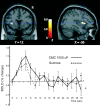Representation in the human brain of food texture and oral fat
- PMID: 15044548
- PMCID: PMC6729847
- DOI: 10.1523/JNEUROSCI.0130-04.2004
Representation in the human brain of food texture and oral fat
Abstract
Important factors that influence food palatability are its texture and fat content. We investigated their representation in the human brain using event-related functional magnetic resonance imaging. It was shown that the viscosity of oral stimuli is represented in the (primary) taste cortex in the anterior insula, in which activation was proportional to the log of the viscosity of a cellulose stimulus (carboxymethyl cellulose), and was also produced by sucrose. Oral viscosity was also represented in a mid-insular region that was posterior to the taste cortex. Third, it was found that oral delivery of fatty vegetable oil activates both of these insular cortex regions, the hypothalamus, and the dorsal midanterior cingulate cortex. Fourth, it was found that the ventral anterior cingulate cortex, where it borders the medial orbitofrontal cortex, was activated by oral fat independently of its viscosity and was also activated by sucrose taste. This ventral anterior cingulate region thus represents two indicators of the energy content and palatability of foods. These are the first investigations of the oral sensory representation of food texture and fat in the human brain, and they start to reveal brain mechanisms that may be important in texture-related sensory properties of foods that make them palatable and that may accordingly play a role in the hedonic responses to foods, the control of food intake, and obesity.
Figures





References
-
- Anderson AK, Christoff K, Stappen I, Panitz D, Ghahremani DG, Glover G, Gabrieli JD, Sobel N (2003) Dissociated neural representations of intensity and valence in human olfaction. Nat Neurosci 6: 196–202. - PubMed
-
- Bush G, Luu P, Posner MI (2000) Cognitive and emotional influences in anterior cingulate cortex. Trends Cogn Sci 4: 215–222. - PubMed
-
- Cerf-Ducastel B, Murphy C (2001) fMRI activation in response to odorants orally delivered in aqueous solutions. Chem Senses 26: 625–637. - PubMed
-
- Collins D, Neelin P, Peters T, Evans AC (1994) Automatic 3D intersubject registration of MR volumetric data in standardized Talairach space. J Comp Assist Tomogr 18: 192–205. - PubMed
-
- Criqui MH, Heiss G, Cohn R, Cowan LD, Suchindran CM, Bangdiwala S, Kritchevsky S, Jacobs Jr DR, O'Grady HK, Davis CE (1993) Plasma triglyceride level and mortality from coronary heart disease. N Engl J Med 328: 1220–1225. - PubMed
Publication types
MeSH terms
Substances
LinkOut - more resources
Full Text Sources
Medical
